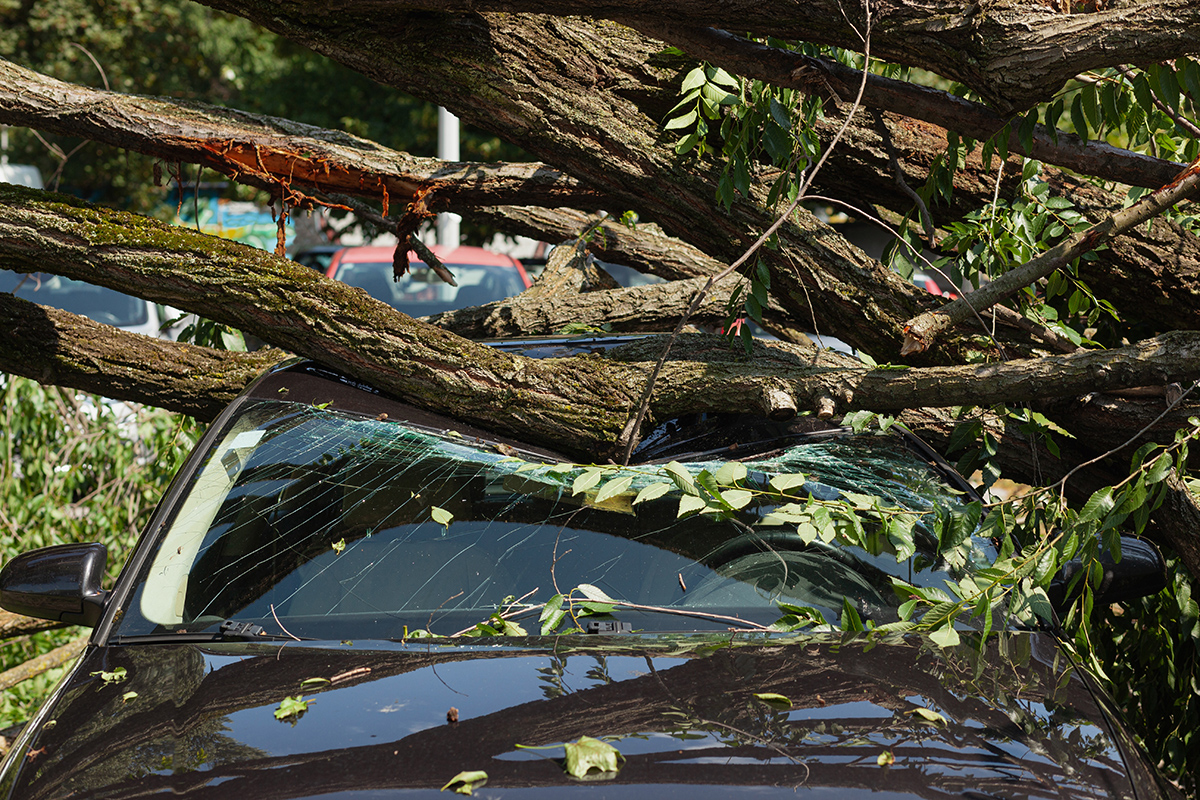Not All Vehicle Damage Is Caused by Other Cars

Roadways, parking lots, and garages are like war zones. Vehicles are constantly under threat from bouncing rocks, swinging car doors – even runaway shopping carts! But Mother Nature can also pack a punch and leave a lasting mark on your vehicle. Whether it's heavy rain, high winds, hail, or flying debris, severe weather poses a significant threat to your car. Knowing what to do after storm damage occurs and understanding how to prevent further damage can save you time, money, and stress.
Types of Storm Damage to Vehicles
Storms can cause different types of damage, depending on the severity and type of weather involved. Here are some common forms of storm damage to vehicles:
- Flood Damage | Heavy rain or rising floodwaters can result in flood damage to your car, which is often the most costly. Water can seep into the engine, interior, and electrical systems, causing extensive damage. Flooding can render a car unsafe to drive or result in long-term issues like rust, mold, and electrical malfunctions.
- Hail Damage | Hailstorms can cause dents, cracked windows, and broken mirrors. The roof, hood, and trunk are especially vulnerable to hail damage. Even small hailstones can leave noticeable dents, while larger ones may break the glass or cause structural damage.
- Wind Damage | Strong winds can carry debris, such as tree branches, rocks, and other objects, that may scratch, dent, or even shatter your car’s windows. Falling trees and branches can cause major damage to the vehicle’s body and windows.
- Lightning Strikes | Although rare, lightning can strike a vehicle, causing damage to the electrical system, tires, or even the paint. It’s a less common form of storm damage but can be serious if it occurs.
- Sand & Dust Storms | Dust storms or sandstorms can cause abrasion to your car's paint and scratch the windshield. The fine particles can also find their way into the engine and other mechanical parts, reducing performance.
What to Do If Your Vehicle Sustains Storm Damage
If your vehicle has been damaged in a storm, follow these steps to ensure your safety and minimize the impact of the damage:
- Assess the Damage
As soon as it’s safe to do so, check your car for visible damage. Look for dents, broken windows, water inside the vehicle, and any mechanical issues like a stalled engine or malfunctioning electronics. Make a note of all the damage you observe, as this will be useful when filing an insurance claim. - Document the Damage
Take photos and videos of the damage from various angles. This documentation will help when dealing with your insurance company and can expedite the claims process. - Check for Safety Concerns
If your vehicle has flood damage, avoid starting it until it’s inspected by a professional mechanic. Water can cause serious engine and electrical issues that could worsen if you try to operate the car. For hail damage, make sure any broken glass or mirrors are temporarily covered to prevent further damage or injury. - File an Insurance Claim
Contact your insurance provider to report the damage. Comprehensive coverage typically covers storm-related damage, including hail, floods, and wind damage. Provide all the necessary documentation, such as photos, a description of the damage, and any relevant details about the storm. Your insurer may recommend an auto body shop for repairs. - Seek Professional Repairs
Once the insurance process is underway, take your car to an auto body shop like Metro Motor Collision for a detailed inspection. Metro Motor's auto body repair experts can assess the damage and provide professional repairs for dents, paint, glass, and other storm-related issues. It's crucial to get repairs done as soon as possible to prevent rust, further mechanical damage, or safety hazards. We can even help you document and file your insurance claim!
How to Protect Your Vehicle from Storm Damage
While it's impossible to completely shield your vehicle from severe weather, there are steps you can take to reduce the risk of storm damage:
Park in a Covered Area
Whenever possible, park your car in a garage or under a carport during storm season. This offers protection from hail, flying debris, and falling branches.
Use a Car Cover
If you don’t have access to a garage, invest in a durable car cover that is designed to protect against the elements, particularly hail.
Monitor Weather Alerts
Stay informed about incoming storms through weather alerts on your phone or local news. If severe weather is predicted, move your vehicle to a safe location and avoid parking under trees or power lines.
Avoid Driving in Storms
Driving in the midst of severe weather increases the risk of accidents or further damage to your vehicle. If you’re caught in a storm, pull over in a safe location until the worst of the weather passes.
Storm damage to a vehicle is an unfortunate event, but understanding how to prevent it and what steps to take afterward can help you recover quickly. If your car has sustained storm damage, contacting a trusted auto body shop, like Metro Motor Collision, for professional repairs is essential to ensure your vehicle is restored to safe, working condition. With proper care and preventive measures, you can minimize the risks and get back on the road with peace of mind.
Vehicle care information made available by Metro Motor is presented as helpful advice for general maintenance and should not be construed as instructions for at-home vehicle service. Be sure to consult your owner’s manual and a licensed, professional mechanic for diagnostics and repair.
